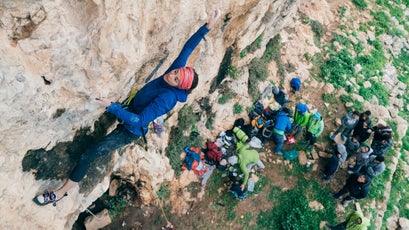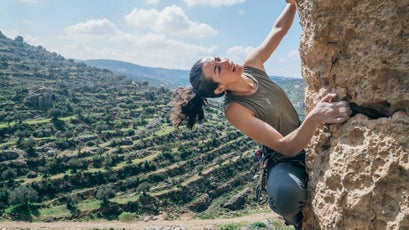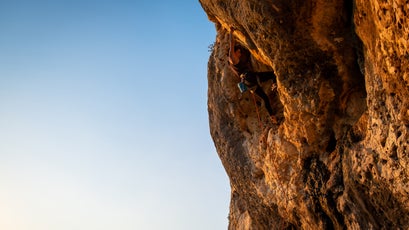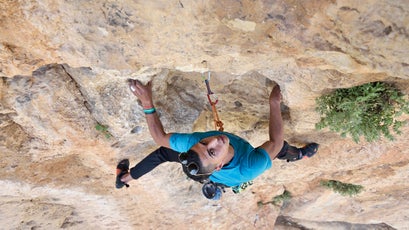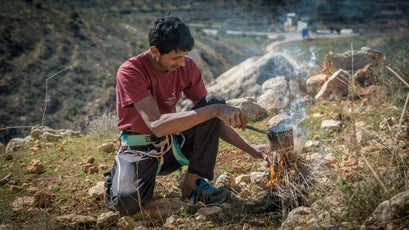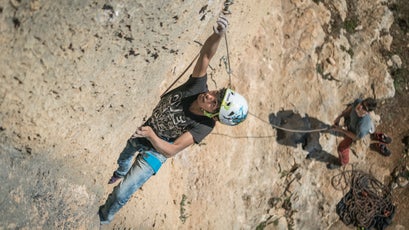Travelers usually visit Palestine’s West Bank for its historic cities and biblical sites, rather than its adventure offerings. But in 2014, Americans Tim Bruns and Will Harris arrived looking to change that. Bruns and Harris were studying abroad in Jordan in 2012 when they first traveled to the West Bank and noticed its untapped climbing potential: towering limestone cliffs without a bolt in sight. The pair had discussed opening an indoor climbing gym in Jordan, but after seeing what Palestine had to offer, they shifted their focus.
Bruns and Harris returned to Palestine in 2014, shortly after graduating from Colorado College. They cobbled together funds from private donors and organizations like USAID to start building the West Bank’s first indoor rock gym, called , in Ramallah, a city less than an hour north of Jerusalem. They also began developing outdoor crags. But they quickly discovered that establishing a climbing scene would take more than just bolting routes.
After the Arab-Israeli war��of 1948, the former British��Mandate of Palestine was broken up��into Israel, the West Bank, and Gaza. Following the Six-Day War in 1967, Israel gained control over the , a 2,180-square-mile territory��bordered by Jordan, Israel, and the Dead Sea. Following the 1993 Oslo Accords, the West Bank was divided��into administrative areas controlled by either Israel or the Palestinian Authority, a political entity that represents Palestinians in the region. About 60 percent of the West Bank is under full Israeli control, today, while��other areas��have varying levels of Palestinian autonomy. Although��some climbing existed in Israeli parts of the West Bank, where there’s limited or no access for many Palestinians, there was no climbing��in Palestinian-held areas and no programs to teach Palestinians the sport.
In order to locate cliffs in Palestinian areas��of the West Bank, Bruns and Harris teamed up with a local hydrologist to overlay topographical maps with a political one. After bolting a few outdoor routes, they started advertising top-roping trips on Facebook. Word spread quickly. Within months, one trip a week turned into four, then six, and they continued to develop routes to fit demand. Now, five years later, the Palestinian West Bank has nine��crags, around 200 routes, an indoor gym, and a new guidebook,����($22),��published this month.
The new West Bank crags are mostly in the area surrounding Ramallah, which sits in a region that boasts world-class cliffs in places like Kalymnos, Greece, and Geyikbayiri, Turkey. “It’s really some of the best limestone I’ve ever climbed on,” Bruns��says. The area is defined by steep, featured faces and peppered with sport��routes and boulders, and grades range from moderate to open 5.14 projects, with plenty in the 5.9 to 5.12 range. The newly bolted cliffs have already attracted pros: Nina Caprez visited in 2014, while Miranda Oakley, Madaleine Sorkin, and Timmy O’Neill made the trip in 2017.
In the years since his first top-roping clinics, Bruns says that climbing has grown exponentially in the local community—he estimates that there have been about 4,000 sign-ups for climbing tours so far. The trips attract both locals and foreigners, including experienced climbers who have volunteered to help teach Palestinians. Bruns, who lived in the West Bank full-time from 2014 to 2017 and now regularly travels there from his home in Colorado, says that one of the things he’s most proud of is the strength of the new��Palestinian climbing community. And Wadi Climbing, which opened in 2016, has become a training and meeting center for it. There’s now an official Palestinian Climbing Club, recognized by the Ministry of Youth and Sport. And while the gym and climbing trips have been run by foreigners in the past, Bruns says that both will be led almost entirely by Palestinians in 2020.
One of the first Palestinians who learned to climb in the West Bank was��Inas, 33��(who asked to be identified by her first name only); she��got her start after seeing a Facebook post about one of Wadi Climbing’s top-roping classes. Inas says the region’s unique political situation is inseparable from everyday life. “When you visit Palestine, you can’t actually ignore the political dimension,” she says. For her and other Palestinians, climbing isn’t just a fun activity, it’s also a way to help deal with the stress of living in a place under��continued conflict. “I started rock climbing because I felt so overwhelmed and depressed, because of the news and feeling like I can’t do anything,” Inas says. “Climbing actually deals with mental and emotional problems��and helps build self-confidence.”
To find crags where Palestinians could climb safely, Bruns and Harris have had to navigate complex political boundaries. Because of the West Bank’s divided rule, Palestinians often can’t use the same roads as foreign climbers or Israelis, even in areas recognized as part of Palestine by international law. Israelis are also barred by their government from entering certain Palestinian-controlled areas.��Bruns notes that all the crags in the guidebook are accessible to Palestinians and foreigners, but some are not open to Israelis.
In the guidebook, Bruns sometimes suggests as many as three different driving directions, depending on a person’s nationality. For example, the book’s Ein Fara chapter, about a crag originally developed by Israeli climbers that’s located some nine miles north of Jerusalem, discusses how those with foreign or Israeli passports can drive directly to the crag but��Palestinians aren’t allowed to get close to the settlement, so they must take an unmarked dirt road that skirts the area or park their vehicle and hike for 45 minutes.
According to Bruns, foreigners don’t face the same access barriers. “Foreigners, especially Americans and Europeans, have free privilege to travel between the West Bank and Israel,” Bruns says. “They’re welcomed in both places.” He also says that perceptions of the West Bank as highly dangerous for tourists are overblown. “In my opinion, the West Bank is safer to travel to than certain parts of South America��or even the U.S.,” he��says. In 2017, Palestine was sixth on the UN��World Tourism Organization’s ranking of the fastest-growing tourism destinations, with a 25.7 percent increase in visitors from 2016. According to the ,��over three million tourists visited the West Bank in the first half of 2018 alone, including 110,000 visits by Americans.
Still, Bruns says it’s wise to be aware of current events. For example, he recommends avoiding areas where demonstrations are happening, especially on Fridays, when the��weekend��starts and protests are more likely. The guidebook also includes warnings for areas where climbers may encounter armed Israeli settlers or military personnel—but Bruns says that’s primarily a concern for Palestinian climbers, not visitors.
Bruns and climbers like Inas hope that Wadi Climbing’s trips will be a way for the international community to meet Palestinians and form their own impressions of the area and culture, going beyond the headlines they see at home. “As climbers, we share many things at the cliff,” Inas says. “Our stories, our backgrounds, and our experiences in climbing and in life. We can actually tell our own story, and you have the choice to listen. At least we get to have our version.”



